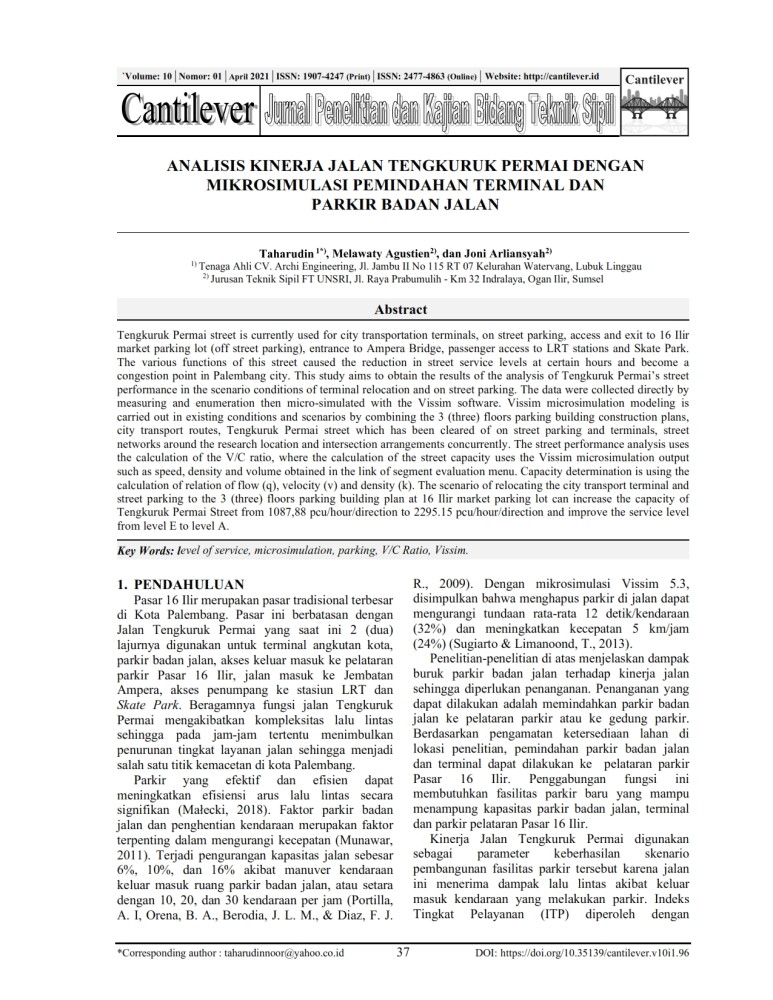Analisis Kinerja Jalan Tengkuruk Permai dengan Mikrosimulasi Pemindahan Terminal dan Parkir Badan Jalan Performance Analysis of Tengkuruk Permai Street with Microsimulation of Terminal Relocation and Street Parking
Main Article Content
Abstract
Tengkuruk Permai street is currently used for city transportation terminals, on street parking, access and exit to 16 Ilir market parking lot (off street parking), entrance to Ampera Bridge, passenger access to LRT stations and Skate Park. The various functions of this street caused the reduction in street service levels at certain hours and become a congestion point in Palembang city. This study aims to obtain the results of the analysis of Tengkuruk Permai’s street performance in the scenario conditions of terminal relocation and on street parking. The data were collected directly by measuring and enumeration then micro-simulated with the Vissim software. Vissim microsimulation modeling is carried out in existing conditions and scenarios by combining the 3 (three) floors parking building construction plans, city transport routes, Tengkuruk Permai street which has been cleared of on street parking and terminals, street networks around the research location and intersection arrangements concurrently. The street performance analysis uses the calculation of the V/C ratio, where the calculation of the street capacity uses the Vissim microsimulation output such as speed, density and volume obtained in the link of segment evaluation menu. Capacity determination is using the calculation of relation of flow (q), velocity (v) and density (k). The scenario of relocating the city transport terminal and street parking to the 3 (three) floors parking building plan at 16 Ilir market parking lot can increase the capacity of Tengkuruk Permai Street from 1087,88 pcu/hour/direction to 2295.15 pcu/hour/direction and improve the service level from level E to level A.
Downloads
Article Details
Departemen_Permukiman_dan_Prasarana_Wilayah. (2004). Pedoman Survei Pencacahan Lalu Lintas dengan Cara Manual.
Małecki, K. (2018). A computer simulation of traffic flow with on-street parking anddrivers’ behaviour based on cellular automata and a multi-agentsystem. Journal of Computational Science, 28, 32-42.
Munawar, A. & Yulianto, R. A. (2017). Penentuan Kapasitas Jalan Bebas Hambatan dengan Aplikasi Perangkat Lunak Vissim. Jurnal Transportasi, 17(2), 123-132.
Munawar, A. (2011). Speed and Capacity for Urban Roads, Indonesian Experience. Procedia - Social and Behavioral Sciences, 16, 382-387.
NCHRP. (2014). NCHRP Report 765:Analytical Travel Forecasting Approaches for Project-Level Planning and Design. TRB.
Portilla, A. I, Orena, B. A., Berodia, J. L. M., & Diaz, F. J. R. (2009). Using M/M/infinite queuing model in on-street parking manoeuvres. Journal of Transportation Engineering, 135, 527-535.
Pribadi, O. S. (2017). engkinian Manual Kapasitas Jalan Indonesia Segmen Jalan Perkotaan dengan Traffic Microsimulation. Yogyakarta: UGM.
Sugiarto & Limanoond, T. (2013). mpact of On-street Parking on Urban Arterial Performance: A Quantitative Study on Travel Speed and Capacity Deterioration. Aceh International Journal of Science and Technology, 63-69.

This work is licensed under a Creative Commons Attribution-NonCommercial 4.0 International License.
Authors who publish with this journal agree to the following terms:
- Authors retain copyright and grant the journal right of first publication with the work simultaneously licensed under a Creative Commons Attribution-NonCommercial 4.0 International License that allows others to share the work with an acknowledgment of the work's authorship and initial publication in this journal.
- Authors are able to enter into separate, additional contractual arrangements for the non-exclusive distribution of the journal's published version of the work (e.g., post it to an institutional repository or publish it in a book), with an acknowledgment of its initial publication in this journal.
- Authors are permitted and encouraged to post their work online (e.g., in institutional repositories or on their website) prior to and during the submission process, as it can lead to productive exchanges, as well as earlier and greater citation of published work (See The Effect of Open Access).
